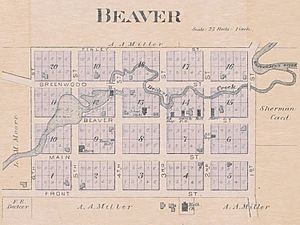Beaver, Minnesota facts for kids
Quick facts for kids
Beaver
|
|
|---|---|

1894 plat map of Beaver
|
|
| Country | United States |
| State | Minnesota |
| County | Winona County |
| Township | Whitewater Township |
| Elevation | 709 ft (216 m) |
| Time zone | UTC-6 (Central (CST)) |
| • Summer (DST) | UTC-5 (CDT) |
| ZIP code |
55910
|
| Area code(s) | 507 |
| GNIS feature ID | 654592 |
Beaver is a small, former community in Minnesota, United States. It's located in Whitewater Township, within Winona County. Even though it's not a bustling town anymore, it has an interesting history. You can find it near where State Highway 74 and Winona County Road 30 meet. The beautiful Whitewater River and Beaver Creek flow through this area. Nearby places include Altura, Elba, Plainview, St. Charles, Weaver, and Whitewater State Park.
Contents
The Story of Beaver
How Beaver Got Its Name
Beaver was first settled in 1854 by people who came from New England. It was the very first community to be started in the Whitewater River valley. The settlers named the area "Beaver" because they saw many beavers building dams on the creek. This creek flows through the site and joins the Whitewater River.
Early Life in Beaver
Inspired by the beavers, the early settlers decided to build their own dam on the creek. This dam helped them create power for a mill, which was very important for grinding grain. In 1856, the community was officially planned out by Albert Hopson, Dr. Sheldon Brooks, and William J. Duley. They laid out 20 blocks on about 40 acres of land.
For many years, Beaver was a busy place. It had its own post office from 1857 to 1906. The community also had a flour mill, where grain was turned into flour. There was a hardware store for tools and supplies, and a general store where people could buy almost anything they needed. Beaver also had a Methodist church, a blacksmith shop, and a wagon shop. There were even a hotel and a school for the children.
Why Beaver Changed
Life in Beaver became difficult because of farming practices on the hillsides. When it rained, soil would wash down the hills, causing erosion. At first, rich soil came down, but then sand from the ground below started washing down year after year. This sand covered everything, making it hard to farm. Some years, farmers had to plant their crops three times because floods kept washing them away.
The floods and sand deposits badly damaged the area. Over time, most of the original town site became overgrown and swampy. In 1932, the state of Minnesota bought most of the land. The old buildings were taken down, and the Beaver area was turned into a nature reserve.
Memories of Beaver
Even though Beaver is no longer a town, its history lives on. Eleanor Putnam, who was 89 years old in 2009, remembered living in Beaver as a child in the 1920s and 1930s. She recalled climbing the hills around Beaver and how her family farmed the tough land. She also remembered her uncle working hard to farm the top of a high plateau.
The Beaver Cemetery, located just west of where the old community center used to be, is a special place. Many of the first settlers of Beaver were buried there. It's a quiet reminder of the people who once called Beaver home.



